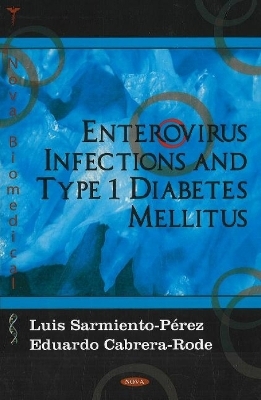
Enterovirus Infections & Type 1 Diabetes Mellitus
Seiten
2006
Nova Science Publishers Inc (Verlag)
978-1-60021-339-7 (ISBN)
Nova Science Publishers Inc (Verlag)
978-1-60021-339-7 (ISBN)
Enteroviruses have been examined for their possible role in the etiology of type 1 diabetes for many years. This book provides a better understanding of enteroviral biology and the potential alternative pathogenic mechanisms through which enteroviruses may cause diabetes.
Enteroviruses have been examined for their possible role in the etiology of type 1 diabetes for nearly 40 years. It is now evident from studies in several countries that enterovirus infection accompanies or precedes the onset of diabetes in many individuals. These evidences include the isolation of coxsackievirus B4 from the pancreas of a child at diagnosis of type 1 diabetes, several epidemiological and prospective studies showing that some cases of type 1 diabetes are strongly associated with enterovirus infections, seasonal incidence studies, case-control studies that show an increased prevalence and levels of IgM antibodies to enterovirus in newly diagnosed patients. Other evidences involves several case studies in which diabetes develops after an enterovirus infections, increased T cell response to enterovirus antigens in type 1 diabetic patients, suggestions that enterovirus infections during pregnancy might initiate the events leading to childhood diabetes, and a higher frequency of enterovirus RNA in the serum/blood of type 1 diabetic patients at diagnosis. This book Provides a better understanding of enteroviral biology and the potential alternative pathogenic mechanisms through which enteroviruses may cause diabetes.
Enteroviruses have been examined for their possible role in the etiology of type 1 diabetes for nearly 40 years. It is now evident from studies in several countries that enterovirus infection accompanies or precedes the onset of diabetes in many individuals. These evidences include the isolation of coxsackievirus B4 from the pancreas of a child at diagnosis of type 1 diabetes, several epidemiological and prospective studies showing that some cases of type 1 diabetes are strongly associated with enterovirus infections, seasonal incidence studies, case-control studies that show an increased prevalence and levels of IgM antibodies to enterovirus in newly diagnosed patients. Other evidences involves several case studies in which diabetes develops after an enterovirus infections, increased T cell response to enterovirus antigens in type 1 diabetic patients, suggestions that enterovirus infections during pregnancy might initiate the events leading to childhood diabetes, and a higher frequency of enterovirus RNA in the serum/blood of type 1 diabetic patients at diagnosis. This book Provides a better understanding of enteroviral biology and the potential alternative pathogenic mechanisms through which enteroviruses may cause diabetes.
Preface; Type 1 Diabetes; Human Enterovirus Infections; Enterovirus - Induced Type 1 Diabetes; Our Contributions to the Association Between Enterovirus Infections Type 1 Diabetes; Index.
| Zusatzinfo | Illustrations |
|---|---|
| Verlagsort | New York |
| Sprache | englisch |
| Maße | 260 x 180 mm |
| Gewicht | 620 g |
| Themenwelt | Medizinische Fachgebiete ► Innere Medizin ► Diabetologie |
| Studium ► 1. Studienabschnitt (Vorklinik) ► Biochemie / Molekularbiologie | |
| ISBN-10 | 1-60021-339-1 / 1600213391 |
| ISBN-13 | 978-1-60021-339-7 / 9781600213397 |
| Zustand | Neuware |
| Haben Sie eine Frage zum Produkt? |
Mehr entdecken
aus dem Bereich
aus dem Bereich
Vol. 1 & 2
Buch | Hardcover (2022)
McGraw-Hill Companies (Verlag)
229,99 €


